The Linn DMS Isobariks from the 80s were like this. Midrange and tweeter on front and top. I'm sure the measurements were disquieting, and the imaging was lousy... but the speakers did sound great.
A bit coloured too. But triamped DMS in my bosses house were a joy to listen too.
dave
As I was reading this thread, I felt like I was maybe learning a little, but, then I realized I was just learning that I don't know s**t. Sorry for the distraction, I'll shut up now, please continue.
This!Yes, even a zen purist full range system should have an appropriate high pass filter that is exactly tuned to the bass reflex, transmission line, or horn frequency cutoff. Very few FR designs have that.
Unfiltered designs are flapping in the breeze and nobody notices. It’s FAR worse in analog systems with turntable rumble. An appropriate filter extends dynamic range by 5-10dB.
I cannot emphasise this clearly enough. This also applies to conventional bass reflex designs, as long as they are not tuned so low that audio signals below them becomes less and less likely, e.g. with my four subwoofers with Eminence LAB 12 in the living room, whose fb is just over 20 Hz.
However, I also have two subwoofers in operation here with an fb of around 40 Hz. It's incredible how level stable they become when you give them a filter that doesn't increase the excursion below fb any more than above it; in this case it was an LR4 highpass filter at around 30 Hz.
Yes, it increases the group delay at the bottom, but firstly this is not particularly audible in this frequency range, and secondly there are also a few tricks to avoid increasing the group delay too much.
Making phase chaotic (with adding indirect tweeter to a fullrange) has nothing to do with the precedence effect. Precedence effect means that chaotic phase sound is coming apparently (subjectively) from the same fullrange, not from the tweeter - just that, nothing else. it will not maintain the linear phase which fullrange aficionados are raving about - мeasurements easily reveal that. Of course that phase "problem" will not be audible, just as the similar phase "problem" in 2-way loudspeakers will not be audible - ears are not so sensitive to phase problems in high frequencies.@Sonce
you do not screw up the phase if you have the indirect tweeter doing nothing below 5khz, 18db filters can help to achieve this.
Just read here about it:
https://en.wikipedia.org/wiki/Precedence_effect
Only if tweeter is in waveguide/horn.The tweeter should have directivity properties, and if you choose beaming to the sides, up or behind the box in order not to interfere with the wave from the front it is not harming the direct wave.
Yes, but see above comments.However indirect tweeters do not need to be time aligned like in a two way where the tweeter beams with the main driver together to the listener.
Hi there,This!
I cannot emphasise this clearly enough. This also applies to conventional bass reflex designs, as long as they are not tuned so low that audio signals below them becomes less and less likely, e.g. with my four subwoofers with Eminence LAB 12 in the living room, whose fb is just over 20 Hz.
However, I also have two subwoofers in operation here with an fb of around 40 Hz. It's incredible how level stable they become when you give them a filter that doesn't increase the excursion below fb any more than above it; in this case it was an LR4 highpass filter at around 30 Hz.
Yes, it increases the group delay at the bottom, but firstly this is not particularly audible in this frequency range, and secondly there are also a few tricks to avoid increasing the group delay too much.
i wonder whether in active subwoofers there is a high pass build in to protect the chassis against subsonic frequencies anyway
the zen purist with a record player as analogue source and a tube amplifier IMHO may have a subsonic filter in the preamp but no active crossover high pass tuned exactly with the bass enclosaure chassis or will hide the subwoofer under the coach to maintain the attitude as a high end purist, i don't know (kidding...)
It's all just my personal opinion - Stefano
Last edited:
Yes, I have compare a dsp corrected DIY speaker with Markaudio chn110 in a big cabinet ( 31 L ) against a Kef ls50 Meta in the same room, and the chn110 is much better sounding, clearer and more dynamic , much better bass and the treble is about equal in quality. The sound from chn110 is cleaner.Hi, has anyone had the opportunity to compare a coaxial speaker with lowther and similar? In your opinion, in a horn-loaded cabinet on both sides of the driver, how would a coax behave? In your opinion (everything is subjective) do you like coaxial drivers?
So why is that ?
Two reasons.
You cant make a transparent crossover in a coaxial speakers, the crossover always gonna be the bottleneck. A coaxial driver has another big dissadvantage compared to a single driver and that is the bass cone is moving and the tweeter in the middle dont. The tweeter thus sits in a variable moving waveguide and this is something that Erin has shown at his homepage. It causes serious modulation issues in the tweeter area. This can be heared as a less clear sound compared to a single driver. If a coaxial is crossed at 400 Hz 24dB/oct the problem is much lesser.
https://www.erinsaudiocorner.com/driveunits/kef-q100-drive-unit/
Last edited:
Nonsense.You cant make a transparent crossover in a coaxial speakers, the crossover always gonna be the bottleneck.
Yes, I have compare a dsp corrected DIY speaker with Markaudio chn110 in a big cabinet ( 31 L ) against a Kef ls50 Meta in the same room, and the chn110 is much better sounding, clearer and more dynamic , much better bass and the treble is about equal in quality.
Am I the only one to notice this flagrant contradiction? The single complaint you have against coaxial (beside crossover) is modulation in the tweeter (treble) area, but somehow fullrange (CHN 110) has the same treble quality ("treble is about equal in quality" - according to you) compared to coaxial (KEF LS50 Meta)!? How it is possible both to have the same treble quality, in spite of that "big disadvantage" from coaxial tweeter modulation?A coaxial driver has another big dissadvantage compared to a single driver and that is the bass cone is moving and the tweeter in the middle dont. The tweeter thus sits in a variable moving waveguide and this is something that Erin has shown at his homepage. It causes serious modulation issues in the tweeter area.
And what about the "Doppler distortion" (in fact - phase modulation distortion) inherent in all fullrange drivers? Coaxial tweeter modulation can be diminished to insignificance in a 3-way loudspeakers with woofer and coaxial mid/tweeter. "Doppler distortion" of fullranges can not be lowered! Besides, "Doppler distortion" spans over several octaves of frequency spectra, while amplitude modulation of KEF LS50 is less than 1 octave.
What about the fullrange cone resonaces? They can't be DSP-ed in time domain! Also, fullrange high frequency dispersion is extremely limited and variable in frequency.
You should want to know something more - fullranges have cone resonances which can't be equalized in time domain, high frequency dispersion is very limited and decrease with frequency, "Doppler distortion" is here to stay no matter what, generally frequency response is far from flat and Baffle Step Correction must be done either with EQ or with passive RL elements (sacrilege!).Thanks, that was what I wanted to know
Nonsense.
Am I the only one to notice this flagrant contradiction? The single complaint you have against coaxial (beside crossover) is modulation in the tweeter (treble) area, but somehow fullrange (CHN 110) has the same treble quality ("treble is about equal in quality" - according to you) compared to coaxial (KEF LS50 Meta)!? How it is possible both to have the same treble quality, in spite of that "big disadvantage" from coaxial tweeter modulation?
And what about the "Doppler distortion" (in fact - phase modulation distortion) inherent in all fullrange drivers? Coaxial tweeter modulation can be diminished to insignificance in a 3-way loudspeakers with woofer and coaxial mid/tweeter. "Doppler distortion" of fullranges can not be lowered! Besides, "Doppler distortion" spans over several octaves of frequency spectra, while amplitude modulation of KEF LS50 is less than 1 octave.
What about the fullrange cone resonaces? They can't be DSP-ed in time domain! Also, fullrange high frequency dispersion is extremely limited and variable in frequency.
Doppler distortion has been measured by Joseph Crowe , using Markaudio chn120
https://josephcrowe.com/blogs/news/markaudio-chr120
…as you can see, its visible on measurements but inaudible in practice.
What about multitone measurement distortion with Markaudio chn120 ?
…again , very low.
What about distortion at higher levels , like 95 dB ?
Very low , much , much better than any Kef ls50 Meta.
Ls50 meta ASR , 96 dB distortion:
https://www.audiosciencereview.com/forum/index.php?threads/kef-ls50-meta-review-speaker.25574/
Last edited:
As I and others can see, this is not "Doppler distortion", but a regular intermodulation distortion. "Doppler distortion" is different and is measured and presented in a very different way. See Rodd Elliott measurements here:Doppler distortion has been measured by Joseph Crowe , using Markaudio chn120
https://josephcrowe.com/blogs/news/markaudio-chr120

…as you can see, its visible on measurements but inaudible in practice.
https://sound-au.com/doppler.htm
What about multitone measurement distortion with Markaudio chn120 ?
…again , very low.
What about distortion at higher levels , like 95 dB ?
Very low , much , much better than any Kef ls50 Meta.
Ls50 meta ASR , 96 dB distortion:
I din't say anything about multitone or harmonic distortion, did I? I didn't say anything because it depends on the specific driver, it doesn't meter if it is fullrange or coaxial. Yes, in this specific case fullrange CHN120 is better... good for him.
Anyway, fullranges are not inherently lower in distortion than coaxials, or any other driver.
What about the extremely non-flat frequency response of fullranges? Like these (from the same Joseph Crowe link):
Note: Frequency response is heavily smoothed with 1/3 octave!
And what about fullrange cone resonances?
Frequency response can be made flatter with extensive use of DSP, but waterfall diagram can not possibly be corrected in any way.
Last edited:
You are right about the frequency response that must be corrected using a single driver with the help of a dsp . A WiiM pro or Ultra is perfect for this. Its ironic that many users of single driver speakers uses tube amplifiers and no eq at all making the sound very colored.
The directivity is not perfect either with a single driver , the speaker narrows at higher frequencies which actually can be beneficial in a very reflective room. So there are tradeoffs .
Edit: the Mark audio chn110 seems to be the best measuring driver by the company , (better frequency response than chn120), and at the same time one of the cheapest. But it needs a big box.
The directivity is not perfect either with a single driver , the speaker narrows at higher frequencies which actually can be beneficial in a very reflective room. So there are tradeoffs .
Edit: the Mark audio chn110 seems to be the best measuring driver by the company , (better frequency response than chn120), and at the same time one of the cheapest. But it needs a big box.
Yes, new amplifiers with integrated DSP are godsend for audiophiles.the frequency response that must be corrected using a single driver with the help of a dsp . A WiiM pro or Ultra is perfect for this.
Yes, I am scratching my head always when I see (or hear) such non-logical decisions.Its ironic that many users of single driver speakers uses tube amplifiers and no eq at all making the sound very colored.
Quality, non-expensive fullrange driver is a good choice for simple audiophile setup with DSP-ed amplifier. I have made several different models of fullrange loudspeakers with BSC LR circuit plus additional RLC notch filters (for use with conventional amps) and they sounded OK. I haven't tried CHN110, but measurements looks promising.the Mark audio chn110 seems to be the best measuring driver by the company , (better frequency response than chn120), and at the same time one of the cheapest. B
Last edited:
Hi there,
i made some CLIO Pocket measurements some years ago of the KEF SP1632 midrange coax, 52 cm mic distance in the room - and i forgot to invert the polarity so that the time range step response looks wrong, but it was done the same for midrange and tweeter
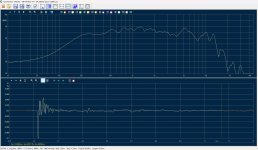
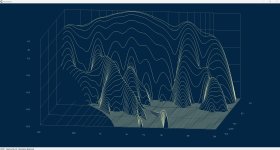
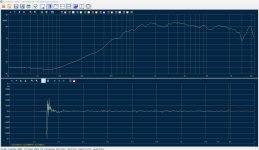
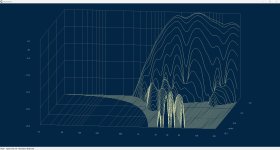
taking into account that some stuff is already coming from the room that is quite non anechoic the response is IMHO a lot of better of what you can get out of a fullrange speaker, especially the tweeter with the patented lemon sqeezer waveguide
i have chosen the wavelet cycle decay representation, tells a lot more than the commaon CSD representation
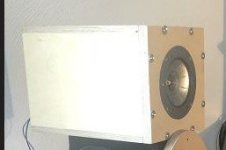
comparison with the best i have got out of a fullrange project for the desktop here, active crossover 330 Hz and some sort of PEQ
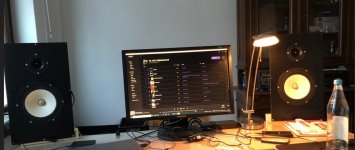

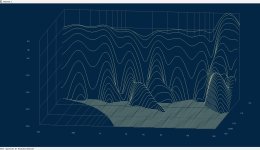
hope it helps, Stefano
i made some CLIO Pocket measurements some years ago of the KEF SP1632 midrange coax, 52 cm mic distance in the room - and i forgot to invert the polarity so that the time range step response looks wrong, but it was done the same for midrange and tweeter




taking into account that some stuff is already coming from the room that is quite non anechoic the response is IMHO a lot of better of what you can get out of a fullrange speaker, especially the tweeter with the patented lemon sqeezer waveguide
i have chosen the wavelet cycle decay representation, tells a lot more than the commaon CSD representation

comparison with the best i have got out of a fullrange project for the desktop here, active crossover 330 Hz and some sort of PEQ



hope it helps, Stefano
Last edited:
Interesting and thank you. Were the SP1632 midrange and tweeter coax time-aligned, and how did they meaure combined? The two sets of IR/FR could not be "added" without knowing the physical time offset of the impulse and post-XO phase responses.i made some CLIO Pocket measurements some years ago of the KEF SP1632 midrange coax
I checked my SP1793 (LS50 meta drivers) for coax time-alignment without XO and it passed. My XO was based on published partial information 3rd-order LP, ~2nd-order HP. No mic measurement though, only musical transcients and careful tone-sweeps by ear.
Hi there,
i have made a functioning three way system with a FA123 hypex plate amp later after the measurements of mid range coax, and they sound very nice, but in the meantime i switched to a bigger multy way horn system and a dirac live room correction, now they are waiting in patience in the cupborad
so far -, so good, Stefano
P.S.:
found a copy posted in another forum
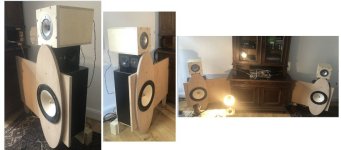
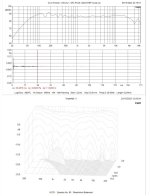
as far as i remember there was the need of very slight delay correction (amount of microseconds that correspond to few mm difference) between cone midrange and dome tweeter of the KEF coax, they are almost time aligned by design
i have made a functioning three way system with a FA123 hypex plate amp later after the measurements of mid range coax, and they sound very nice, but in the meantime i switched to a bigger multy way horn system and a dirac live room correction, now they are waiting in patience in the cupborad
so far -, so good, Stefano
P.S.:
found a copy posted in another forum


as far as i remember there was the need of very slight delay correction (amount of microseconds that correspond to few mm difference) between cone midrange and dome tweeter of the KEF coax, they are almost time aligned by design
Last edited:
- Home
- Loudspeakers
- Full Range
- coaxial vs fullrange